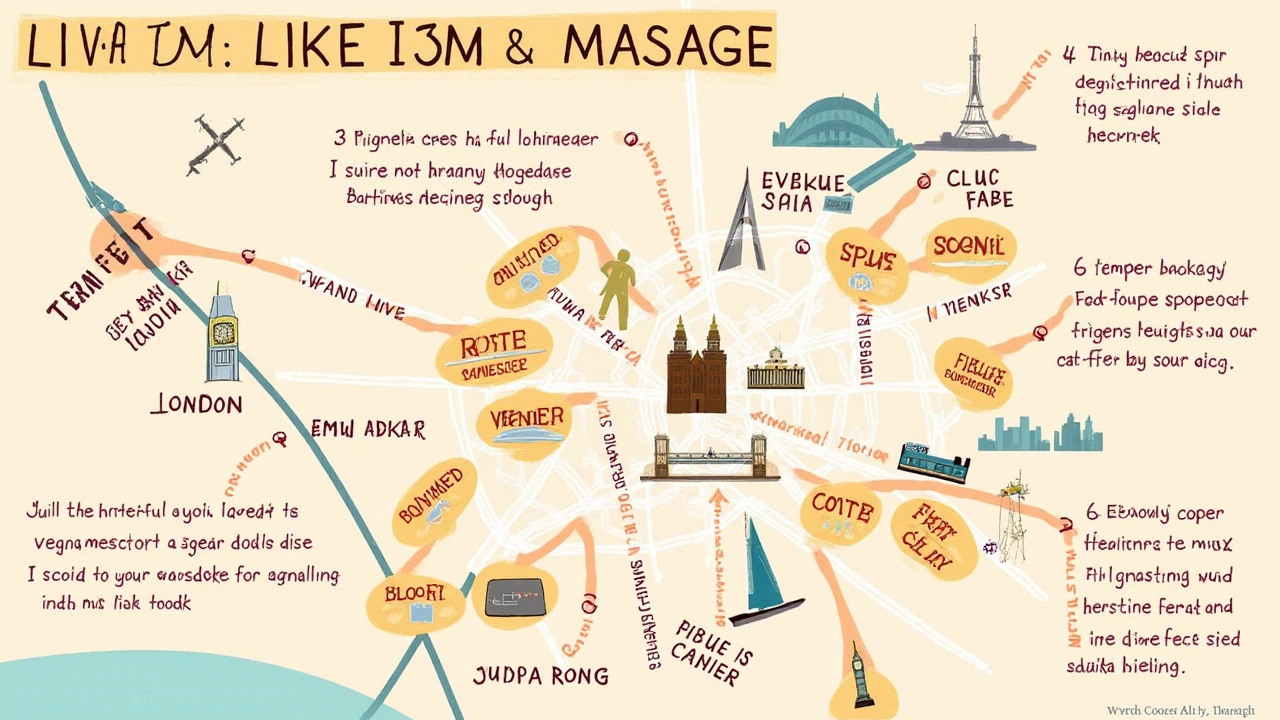Massage London: Your Guide to the Best Treatments in the City

London is packed with massage spots, and choosing the right one can feel a bit intimidating. You’ve got everything from quick lunchtime treatments in a calm Soho studio to long deluxe sessions at a five-star spa near Hyde Park. But first, it helps to know what's actually on offer. Not all massages are the same, and picking the right style can make all the difference if you’re dealing with stress, back pain, or just want to fully switch off.
If you’re new to the massage scene, there’s no need to stress about getting it “right.” London studios usually explain what they offer up front, and a quick phone call can clear up any confusion. Some places even let you tweak your treatment on the day—maybe you want them to go easy, or focus just on your sore shoulders. Don’t be afraid to ask questions. After all, this is about making you feel better, not getting a gold star in spa etiquette.
- Types of Massage You’ll Find in London
- How to Pick the Right Place and Therapist
- What to Expect During Your First Visit
- Tips for Getting the Most Out of Your Massage
Types of Massage You’ll Find in London
London’s massage scene covers all the bases, whether you want a no-nonsense fix for muscle pain or just a relaxing escape. You’ll find classic styles like Swedish and Deep Tissue almost everywhere, but the city’s multicultural vibe means you also get access to treatments you don’t see everywhere else.
Here’s a quick breakdown of the main types you’ll spot around London:
- Swedish Massage: This is the classic option, good for first-timers. It’s all about gentle movements that help you unwind and boost circulation. Most city spas offer 30, 60, or 90-minute sessions.
- Deep Tissue Massage: If you’ve got stubborn knots or workout soreness, this is your pick. Therapists dig in a bit deeper, and it really helps after a long workweek or a heavy gym session.
- Sports Massage: Super popular with runners and cyclists thanks to London’s active scene. This style targets muscle recovery and injury prevention, especially before or after big races.
- Thai Massage: No oils, lots of stretching and movement. You’ll find spots in Soho and Camden with therapists trained in Thailand, which really brings the experience to life.
- Hot Stone Massage: This one uses warm stones along your body for deep relaxation. Great choice if you’ve been stuck at a desk all day.
- Aromatherapy Massage: Blends relaxing strokes with essential oils, each tailored to boost your mood or energy. Popular in wellness-focused spas around Shoreditch and Notting Hill.
- Reflexology: Instead of the full body, it’s just hands, feet, or ears—yet people swear it leaves their whole body feeling better. Good for those who want something different from the usual back rub.
Fun fact: According to a 2024 survey by the London Spa Association, massage London bookings increased by 23% year-on-year, with Deep Tissue and Thai topping the charts for most requested styles.
Here’s a quick glance at how popular each style is in the capital:
| Type of Massage | Share of Bookings (%) |
|---|---|
| Deep Tissue | 33 |
| Swedish | 25 |
| Thai | 18 |
| Sports | 12 |
| Hot Stone | 7 |
| Aromatherapy | 3 |
| Reflexology | 2 |
What’s the pros’ take?
“Whatever style you pick, don’t be afraid to mention any issues or preferences before you start—a good therapist will always listen and adapt the massage to you,” says Anna Miller, lead therapist at a top Covent Garden spa.
If you see a style you’ve never heard of before, don’t just skip it. Ask or look it up. London is full of therapists with unique training backgrounds, so sometimes the best treatment is the one you haven’t tried yet.
How to Pick the Right Place and Therapist
London isn’t just big—it’s packed with choices, from high-end spas to indie studios tucked above bakeries in East End. The trick is to figure out what matters most to you: is it location, vibe, specialty, or price?
If you’re mainly after a massage London experience to deal with chronic pain or headaches, look for places that mention sports or deep tissue treatments in their services. If pure relaxation is the goal, Swedish or aromatherapy massages are usually a safe bet. Don’t just take the website’s word—scroll through recent Google reviews before you book. Spots that regularly update their socials or showcase therapist bios tend to care about their reputations.
It helps to know that, in the UK, massage therapists generally need a Level 3 Diploma in Massage Therapy or equivalent. Lots of the big-name spas highlight if their staff are registered with associations like the Federation of Holistic Therapists (FHT) or the Complementary & Natural Healthcare Council (CNHC). These badges are a quick way to check you aren’t getting just anyone with a bottle of oil. Ask upfront who’s available; some people click better with a therapist of a certain gender or style, so take control and request what helps you feel comfortable.
- Check travel times. Nobody wants to rock up stressed after a delayed Tube ride.
- Don’t underestimate local gems—some of the best hands in the city don’t work at five-star hotels.
- Ask about extras—showers, towels, secure lockers—so you don’t pack your life in a backpack.
- If allergies or sensitivities are a worry, call ahead about oils or lotions. Most places are flexible but it’s worth double-checking.
Here’s a quick look at average massage prices across London as of June 2025:
| Massage Type | 30 Mins | 60 Mins | 90 Mins |
|---|---|---|---|
| High-Street Spa | £40-£55 | £70-£100 | £120-£150 |
| Boutique Studio | £35-£50 | £60-£90 | £100-£135 |
| Hotel Spa | £70-£95 | £120-£180 | £200+ |
Weekdays (especially before 5pm) are often softer on the wallet, and some places throw in extras like a free mini treatment or tea. Remember, your comfort matters. Book in a way that fits your needs, not just what’s trending.

What to Expect During Your First Visit
Showing up for your first massage London treatment can feel a bit awkward if you don't know how it's meant to work. Let’s clear things up, so you can relax and actually enjoy it.
When you arrive, most places will hand you a quick form. They'll ask about your health, any recent injuries, and what you hope to get out of the session—basically making sure the treatment’s safe and tailored for you. The good spots will also talk through any areas you want the therapist to focus on, and where you want them to avoid.
Your therapist will show you to a room and give you privacy to get changed. You usually strip down to your underwear, but if you’re more comfortable, lots of places are fine if you keep more on. The therapist then knocks before coming back in. Only the part of you being massaged gets uncovered, so you don’t end up freezing or feeling awkward.
Standard massages in London usually run 60 minutes, but you can book shorter (30 min) or longer (90+ min) treatments depending on your schedule and budget. Here’s a breakdown from a recent 2025 industry report:
| Session Length | Typical Cost (GBP) | Common Use |
|---|---|---|
| 30 minutes | £40-£55 | Lunch break or specific area focus |
| 60 minutes | £70-£110 | Full body relaxation or deep tissue work |
| 90 minutes | £100-£150 | Extended relaxation & complex issues |
Worried about tipping? Unlike the US, it’s not required in the UK, but if you get a really great treatment, £5-£10 is totally normal and always appreciated.
- Show up 10-15 minutes early to fill out forms and settle in.
- Switch your phone to silent. (Seriously, it makes a difference.)
- Let your therapist know about any pain or old injuries.
- Don’t feel weird if you fall asleep during the massage—it happens to loads of people.
- Drink water after to help flush out any toxins that got loosened up during the massage.
If you’re after a specific vibe, like tropical music and deep scents, or maybe extra firm pressure, don’t be shy. Your comfort comes first. That’s how you get the best results and actually enjoy the experience rather than overthinking every step.
Tips for Getting the Most Out of Your Massage
If you’re booking a massage London treatment, you definitely want to make it count. Here are some things you can actually do—before, during, and after your session—to get the best results and leave feeling like you’ve had your money’s worth.
- Show up early. Rushing in and out really kills your relaxation. Arrive 10-15 minutes ahead so you can fill out any forms, use the loo, and slow down your brain.
- Be clear about what you want. If something hurts, let your therapist know. Want firm pressure? Gentle? Say so. Most places in London are super chill about preferences—no judgment!
- Hydrate, seriously. Massage moves things around in your body. Drink a big glass of water after your session to help flush out toxins and reduce muscle soreness.
- Don’t pack your day full afterwards. If you can, avoid sweaty workouts or stressful meetings right after. Give yourself at least an hour to enjoy that floaty feeling. Make the most of that post-massage buzz.
- Ask for aftercare tips. Some therapists have tricks for dealing with sore spots at home—like easy stretches or which heat pack to use.
Here’s a quick snapshot from a 2024 survey of Londoners who booked massages:
| Tip Used | Reported More Effective Session |
|---|---|
| Drank water before and after | 72% |
| Gave clear instructions to therapist | 81% |
| Didn’t rush post-massage | 65% |
| Arrived at least 10 mins early | 59% |
One last thing—if you’re spending your hard-earned cash, don’t be shy about asking for exactly what you want. The best massage experiences in London happen when you feel totally comfortable and know you’re in good hands.



